Table of contents
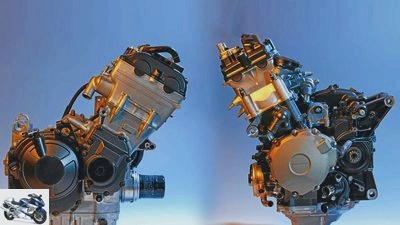
fact
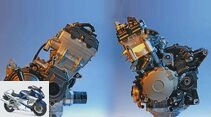
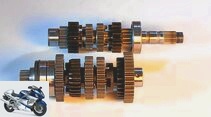
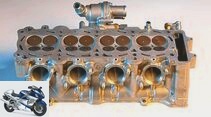
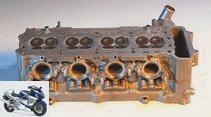
23 pictures
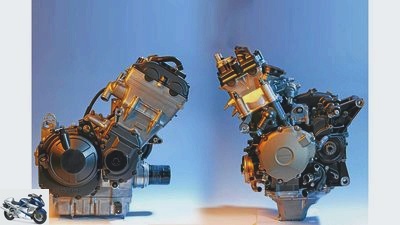
fact
1/23
The Honda Fireblade has been a great performer for twenty years. PS takes a close look at the development of engine technology. What has happened since the Fireblade from 1992 (SC 28) to 2012 (SC 59). The old engine on the left and the new engine on the right.
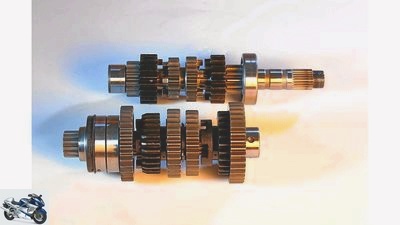
fact
2/23
Old: Barely noticeable differences on the gearbox.
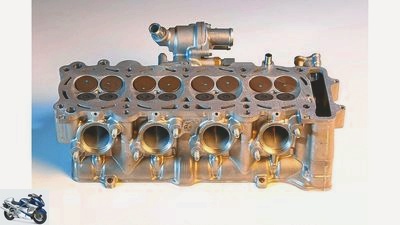
fact
3/23
New: It is easy to see how lush the inlet valves of the SC 59 are in relation to the entire combustion chambers and the combustion chambers of the SC 28.
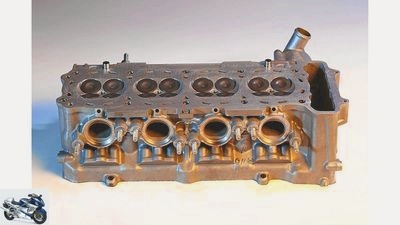
fact
4/23
Old: the cylinder head of the SC 28.
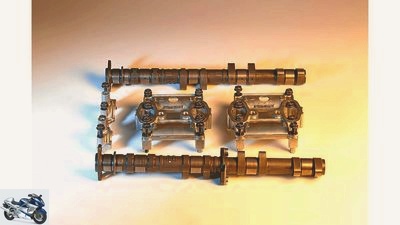
fact
5/23
New: The SC 59 are now divided into blocks.

fact
6/23
Old: The camshaft bearing blocks of the SC 28 still extend over the entire length of the camshaft.
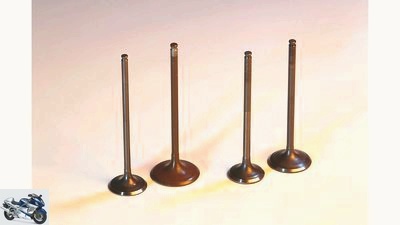
fact
7/23
Also lighter and bigger, the valves of the CBR 1000 RR. (left: new; right: old)
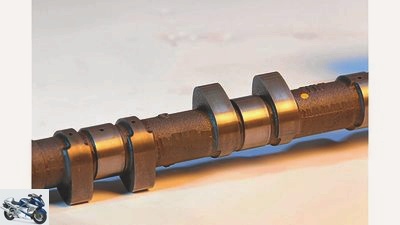
fact
8/23
New: The camshafts of the new Blade are significantly lighter than the old ones.
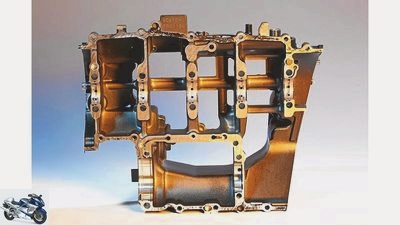
fact
9/23
New: On the SC 59 motor, only the output shaft is on this housing level – the input shaft is above it.
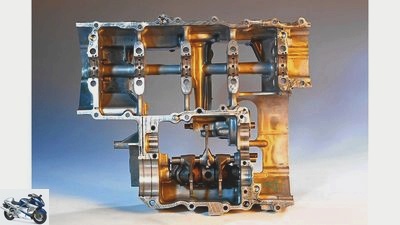
fact
10/23
Old: It is easy to see from the lower parts of the engines: In the SC 28 unit, the gear shafts are still arranged one behind the other.
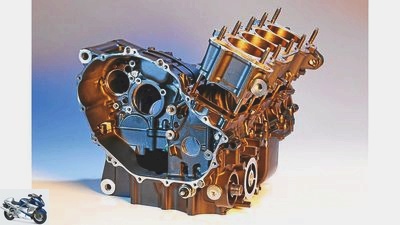
fact
11/23
New: The cylinder bank of the SC 59 is screwed on and not cast on as on the SC 28.
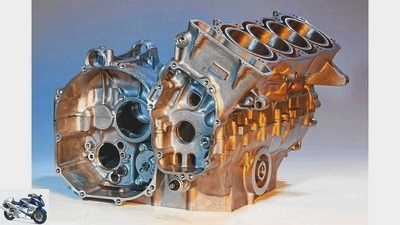
fact
12/23
Old: The old engine of the SC 28 is a kilogram lighter, but also has to withstand less.

fact
13/23
New: The current SC 59 is much finer.
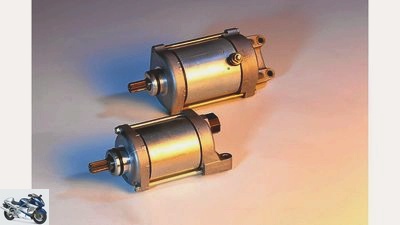
fact
14/23
New at the bottom, old at the top: the size of the starter motors for the blades.
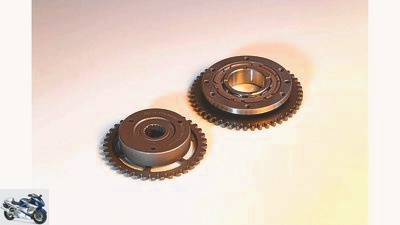
fact
15/23
New on the left, old on the right: the freewheels on the new Fireblade are also much smaller in comparison.
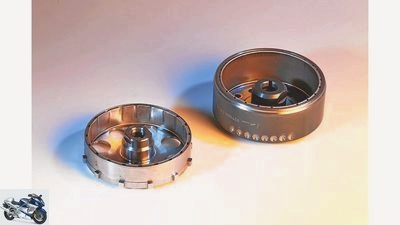
fact
16/23
New on the left, old on the right: the alternator rotors of the machines.
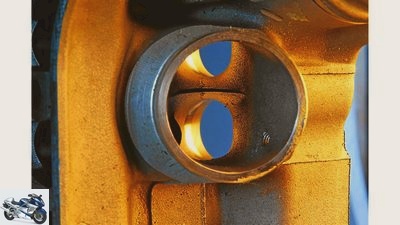
fact
17/23
Old: The rougher surface of the intake ducts increases the flow resistance in the intake tract.
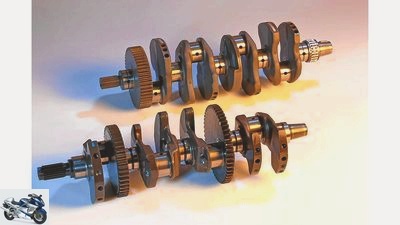
fact
18/23
New at the bottom, old at the top: the SC 59 crankshaft is a whopping 805 grams lighter.
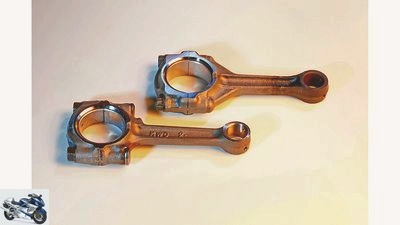
fact
19/23
Old downstairs, new upstairs: the overall package is only 15 grams heavier despite the higher load.
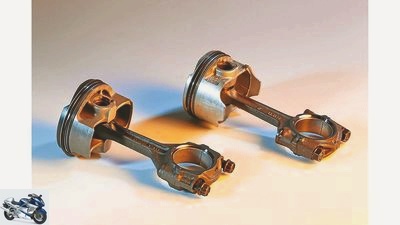
fact
20/23
New on the left, old on the right: progress becomes visible. The piston skirts of the new piston are significantly shorter.
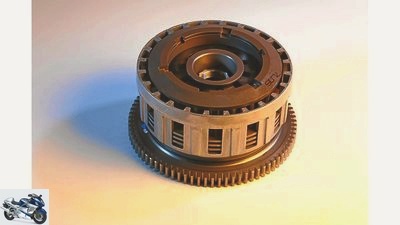
fact
21/23
New: The standard anti-hopping clutch of the 1000 Fireblade weighs 5165 grams.

fact
22/23
New: Although the new transmission has to transmit significantly more power, it is not blatantly larger or lavishly dimensioned. Still, it’s over 700 grams heavier.
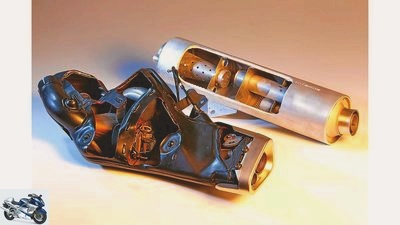
fact
23/23
New at the bottom, old at the top: The simple word rear silencer might still fit the SC 28 pot, but definitely not the complex exhaust system of the SC 59.
counselor
technology & future
Technology: engine technology super sports car
Technology: 20 years of progress in engine technology
20 years of Fireblade: Part 2
Content of
Super athletes are the development vehicles. What has happened to their engines in the last 20 years? PS takes a close look at the development of the Honda Fireblade.
Robert luck
11/20/2012
The Honda Fireblade has been a great performer for twenty years. A lot has happened during this time. The displacement of the sports motorcycles known as superbikes grew from 750 to 1000 cubic meters, the former exotic Honda Fireblade with 900 cubic meters was transformed into a regulation-compliant racer with a displacement of one liter, and the characteristic, but not always good, 16-inch front wheel of the SC 28 / SC 33 series (1992 to 1999) was replaced by a conventional, 17-inch front wheel. In addition to the sonorous name “Feuerklinge”, one thing in particular has remained: the drivability that was inherent in it from the start.
Last time we examined the dynamic progress of the superbikes on the Honda Fireblades from 1992 (SC 28) and 2012 (SC 59). Now we turn to the aggregates of these two missiles. Disassemble, weigh, measure and inspect the power plants meticulously in order to track down the further development of engine technology. The Honda Germany training facility, the Honda Academy, provided a great help here, where we were allowed to dissect, examine and photograph both engines under expert guidance.
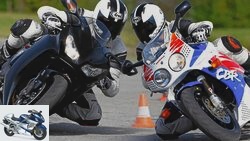
Super athlete
Technology 20 years of progress in motorcycle construction
20 years of Fireblade: Part 1
read more

fact
Honda trainer Grobmann and PS editor are screwing luck.
The first approach to the two in-line four-cylinder units takes place from the outside, with an eye, measuring tape and scales. The more compact an engine is, the more assembled its masses are and the lighter it is, the better it can be accommodated in the overall motorcycle system. With a similar cylinder bank angle, the two engines do not give each other much at first. The modern SC 59 motor is 15 mm narrower, 30 mm shorter, but 60 mm higher than the SC 28 drive. In addition, with a total weight of 62.5 kg, it is a whopping two kilos heavier than the older 900 cubic engine. And that’s called progress? Yes, because despite the larger bore, the engine has become narrower, its 30 mm shorter overall length allows the installation of a longer swing arm that promotes traction without having to lengthen the wheelbase. The greater overall height is mainly caused by the deeper drawn oil pan, which helps to minimize the splash loss in the engine through this design (more on this later). In addition, you have to keep in mind that the SC 59 engine generates a liter output of 178 hp at 12,000 rpm, while the SC 28 four-cylinder only pushes 140 hp / liter at 10,500 rpm and thus significantly lower loads on the Is exposed to storage.
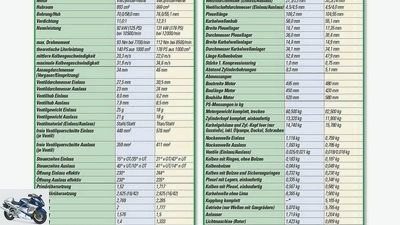
archive
The measured values in comparison.
A look at the table (left) shows what has happened in terms of casting and manufacturing technology. Almost every component of the modern SC 59 that we put on the scales was lighter than that of the SC 28 – with the exception of the crankcase. The old engine housing of the 900s is a kilogram lighter than the current one. This is also due to the fact that the 1000 cc engine has to cope with over 220 hp in racing without breaking. In this way, the two kilos extra weight of the modern engine can be put into perspective very quickly. After all, it not only has to defy the significant increase in horsepower and Newton meters, it also has a balancer shaft that runs against the direction of rotation of the crankshaft, reduces vibrations and generates more flywheel mass. The SC 28 lacks this, which is at the expense of running smoothness.
Where does this 38 hp increase in liter output come from? We leave out the aspects of the mixture preparation here, that leads too far at this point (CBR 900 RR carburetor / CBR 1000 RR injection). Let us turn to the pure mechanics of the engines. The stroke / bore ratio is essential for the performance and performance development of an engine. The two Honda engines are sportily designed engines and thus short-stroke engines, i.e. units in which the bore is significantly larger than the stroke. The SC 59 has a modern stroke / bore ratio of 0.735, the SC 28 a more conservative one of 0.828. This design has a performance advantage for the SC 59. Another advantage can be found in the cylinder head. Due to the large bore, large valves can be accommodated in the cylinder head for quick filling of the combustion chamber with fresh gas and for quick disposal of the exhaust gas. This process is called gas exchange. Since the exhaust gases, in contrast to the fresh gases, are not sucked in but pressed through the outlet valves at high pressure, they can be significantly smaller than the inlet valves.
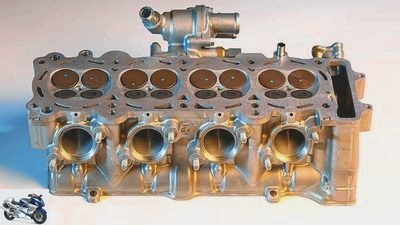
fact
It is easy to see how lush the inlet valves of the SC 59 are in relation to the entire combustion chambers. The combustion chambers of the SC 28 are much smaller.
In addition to its generally shorter-stroke motor design, the current SC 59 has the striking advantage of a six millimeter larger bore (SC 59 76.0 mm / SC 28 70.0 mm). This means that significantly larger valves can be accommodated in their combustion chambers than in those of the SC 28. Its titanium alloy intake valves alone, with a diameter of 30.5 millimeters, are three millimeters larger than those of the old Blade. Amazingly, however, the exhaust valves only grew by one millimeter from 23 mm to 24 mm. This shifted the valve ratio (exhaust valve to intake valve) from 1: 1.20 (SC 28) to 1: 1.27 (SC 59). A detail that you have to take a closer look at, because the gas exchange through the valves is of decisive importance for the performance of an engine.
In addition to the actual valve size, i.e. the diameter, the area that is offered to the fresh or exhaust gas to get in and out of the cylinder is of great importance. This space is called the free valve cross-section and is an indication of the “breathability” of a combustion chamber. In order to show this in a comparison of the motors, we have determined the free valve cross-section at the maximum valve lift. And this is where the new and old Fireblade engines differ significantly. In the current SC 59 cylinder head, 29 percent more inlet area is available for fresh gas per inlet valve, and at least 14 percent at the outlet. The SC 28 is therefore much more cramped.
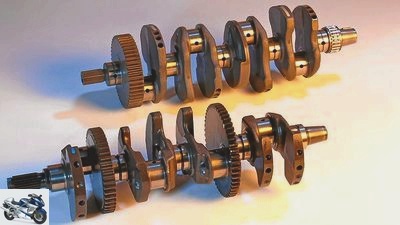
fact
New at the bottom, old at the top: the SC 59 crankshaft is a whopping 805 grams lighter.
The valve lift curve also has an influence on the gas exchange. It specifies the opening stroke and the opening time of a valve. The valve lift curve results from the cam profile on the camshaft and determines when and how long the valves open and close and at what speed they do so. Here, too, it is noticeable that the SC 59 has longer control times, i.e. longer valve opening times, on both the inlet and outlet valves. The SC 59 has 14 degrees longer opening times on the inlet side and five degrees longer on the outlet side. The progress is impressively visible in the area of the cylinder head, especially since a modern Fireblade engine does not cause any durability problems and mobilizes over 220 hp in racing trim.
But when it comes to the performance of a motor, the oscillating and rotating masses are also important. The piston and parts of the connecting rod mass are called the oscillating mass, i.e. the components that move up and down. The lower their weight, the higher the possible speed and thus the theoretically achievable performance. In our case that means specifically: The package piston, piston pin and connecting rod (including bearing shells) weighs 567 grams for the old SC 28 and 582 grams for the current SC 59. Progress? Of course, because the SC 59 piston is six millimeters larger in diameter, after all it has to fill the 76 bore. On the other hand, the connecting rod is 4.65 mm shorter, but that doesn’t make it any lighter than the older component.
The reason for this is to be found in the higher speeds of the modern engine. The mean piston speed of the CBR 900 RR engine is 20.3 m / s – a value of 20 m / s has long been considered the upper limit of durable engines. Only pure racing engines were expected to have higher piston speeds. The CBR 1000 RR SC 59 has an average piston speed of 22 m / s and is only able to survive in the long term because of better materials on the piston, piston pin and connecting rod. The progress here lies in the quality of the materials used, which have only minimally increased the oscillating mass despite the massive increase in performance.
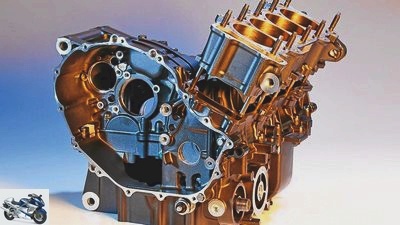
fact
The cylinder bank of the SC 59 is screwed on and not cast on as on the SC 28.
Another aspect to increase the efficiency of an engine is to minimize internal friction. Friction and thus resistance arise on the contact surfaces of all moving components of a motor. In other words, at all bearing points and gears, between piston rings and cylinders, but also directly on the crankshaft drive. What is striking about the CBR engines is that, for example, the connecting rod bearings of the SC 59 have become larger and wider, but not the crankshaft main bearings – despite the significant increase in performance. Instead, the thickness of the compression rings on the pistons was reduced from 1.0 mm on the SC 28 to 0.75 mm on the SC 59. In addition, the cylinder liners of the SC 59 have a special, low-friction coating, which, according to Honda, is for manufacturing reasons makes the cylinder block screwed onto the housing necessary.
A lot of fine-tuning everywhere that doesn’t immediately catch the eye. What is unmistakable, however, is a serious change in the engine design. Although the deep-drawn oil pan mentioned at the beginning increases the overall height of the SC 59 engine, it makes up for this disadvantage for several reasons. With regard to internal friction, it has the advantage that the crankshaft always rotates above the oil level, which minimizes the so-called splash loss. Pansch loss is the resistance that arises when the crankshaft rotates through engine oil. This also ensures a safe oil supply in the event of violent acceleration or braking. In the housing, the pistons zooming up and down create a violent alternation between negative pressure zones under a piston that is pushing upwards and overpressure zones under a piston that is pushing downwards. The back and forth of air in the crankcase is called pumping loss. It can only be reduced by good cross ventilation in the housing. The SC 59 engine has also been improved here.
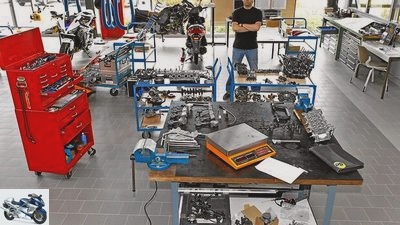
fact
Mission accomplished! We completely dismantled both drives, devastated the workshop and mixed up the parts – it’s time to go.
The 20 years between the original drive and the current version are evident in many respects, for example in the superimposed gear shafts that make the SC 59 engine more compact. But it is the sum of many changes that produce an overall result. When assessing the engines, you shouldn’t forget the intake tract and the mixture preparation. While the SC 28 quad was still running with carburetors, a SC 59 engine could not get a horse out of it without its injection. If you take a closer look at the inlet cross-sections – they also serve as indicators of the performance of an engine – it quickly becomes clear where the power of an SC 59 comes from. It has an intake cross-section that is 83 percent larger than the SC 28. If you now take into account the exhaust gas and noise limits that existed then and now, it is actually a miracle that a current Fireblade is still so powerful and yet drivable. And this miracle means: 20 years of hard development work down to the last detail.
Thank you very much
And again I have to say thank you. This time we bow to Honda Deutschland GmbH, who took us in for a day in their Honda Academy training center and, in addition to the training engines for dismantling, also provided supervisors and workshop space. We were supported on site by two-wheeler master Thomas Grobmann (51), who has been working as a trainer in Honda’s advanced training system since 1997. He was also allowed to put the chaos we created back in order. Thank you very much!
<!– ESI FOR ads.BannerGallery / irelements / esielement / eyJwYWdlIjoiL3N0YXJ0c2VpdGUvIiwibGF5b3V0IjoiYXJ0aWNsZSIsImVsZW1lbnQiOiJhZHMuQmFubmVyR2FsbGVyeSIsImlyQ29uZmlnIjoiMTQ3MzE5NDMiLCJwYXJhbXMiOnt9LCJpc01vYmlsZSI6ZmFsc2V9 –> <!– CACHEABLE –>&# 34;,&# 34; rectangle&# 34 ;: “<!–# include virtual = \&# 34 / irelements / esielement / eyJwYWdlIjoiL3N0YXJ0c2VpdGUvIiwibGF5b3V0IjoiYXJ0aWNsZSIsImVsZW1lbnQiOiJhZHMuUmVjdGFuZ2xlR2FsbGVyeSIsImlyQ29uZmlnIjoiMTQ3MzE5NDMiLCJwYXJhbXMiOnt9LCJpc01vYmlsZSI6ZmFsc2V9 \&# 34; –> <!– ESI FOR ads.RectangleGallery / irelements / esielement / eyJwYWdlIjoiL3N0YXJ0c2VpdGUvIiwibGF5b3V0IjoiYXJ0aWNsZSIsImVsZW1lbnQiOiJhZHMuUmVjdGFuZ2xlR2FsbGVyeSIsImlyQ29uZmlnIjoiMTQ3MzE5NDMiLCJwYXJhbXMiOnt9LCJpc01vYmlsZSI6ZmFsc2V9 –> <!– CACHEABLE –>&# 34;,&# 34; sky&# 34 ;: “<!–# include virtual = \&# 34 / irelements / esielement / eyJwYWdlIjoiL3N0YXJ0c2VpdGUvIiwibGF5b3V0IjoiYXJ0aWNsZSIsImVsZW1lbnQiOiJhZHMuU2t5R2FsbGVyeSIsImlyQ29uZmlnIjoiMTQ3MzE5NDMiLCJwYXJhbXMiOnt9LCJpc01vYmlsZSI6ZmFsc2V9 \&# 34; –> <!– ESI FOR ads.SkyGallery / irelements / esielement / eyJwYWdlIjoiL3N0YXJ0c2VpdGUvIiwibGF5b3V0IjoiYXJ0aWNsZSIsImVsZW1lbnQiOiJhZHMuU2t5R2FsbGVyeSIsImlyQ29uZmlnIjoiMTQ3MzE5NDMiLCJwYXJhbXMiOnt9LCJpc01vYmlsZSI6ZmFsc2V9 –> <!– CACHEABLE –>&# 34;}}” ga-track-vis =”article.gallery.inline.vis” class =”v-A_-article__inline-container”>
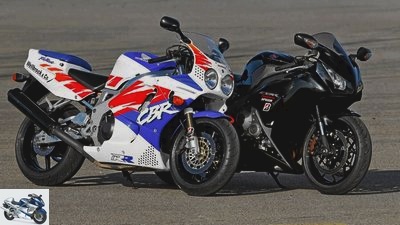
fact




14th pictures
Images: Technology: 20 years of progress in engine technology
go to Article
To home page
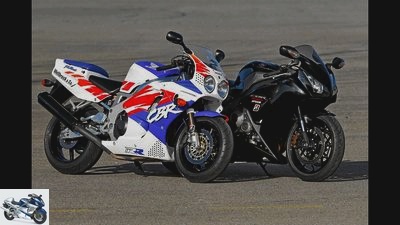
fact
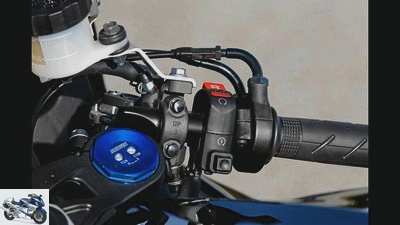
fact
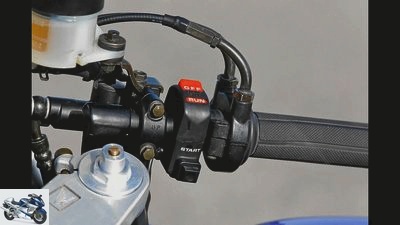
fact
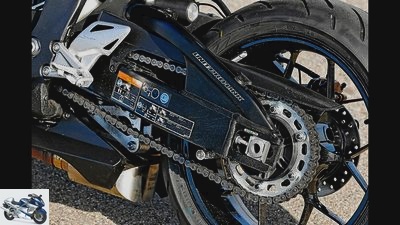
fact
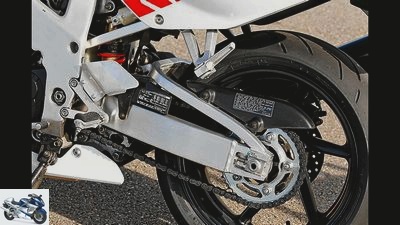
fact
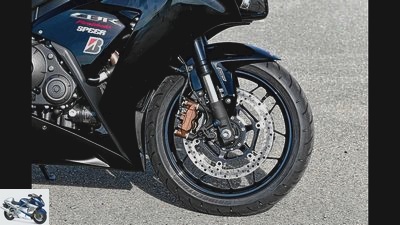
fact
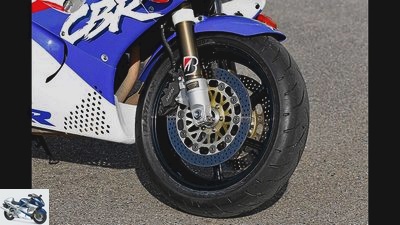
fact
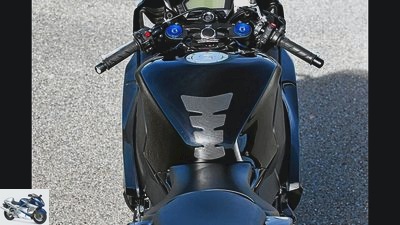
fact
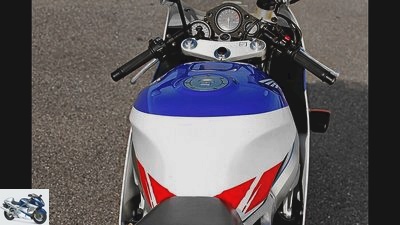
fact
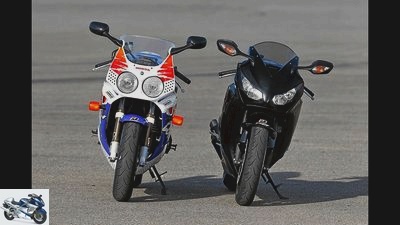
fact
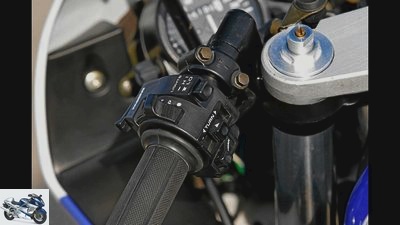
fact
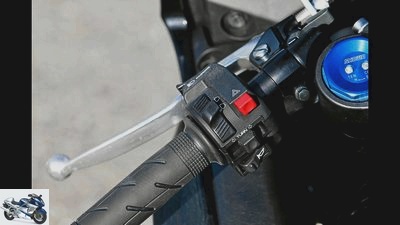
fact
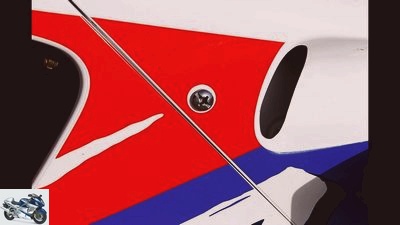
fact
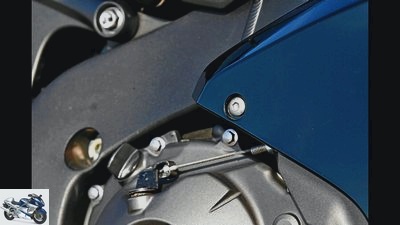
fact
1/14

Super athlete
Technology 20 years of progress in motorcycle construction
20 years of Fireblade: Part 1
read more
PS readings
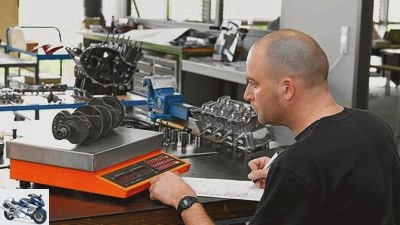
fact
Who measures, measures (often) manure. We make every effort to correctly determine the component weights.
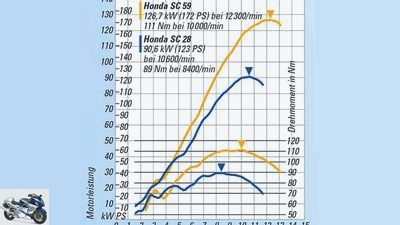
archive
The performance of the Fireblades in comparison.
Performance diagram:
Bartel fetches the must! The SC 59 downgrades the SC 28 to a moped. The old Fireblade can only keep up to some extent in terms of performance. Otherwise the development of the last 20 years becomes more than clear. From 5000 rpm, the CBR 1000 pulls the CBR 900 up and away, surpassing it sustainably in all speed ranges.
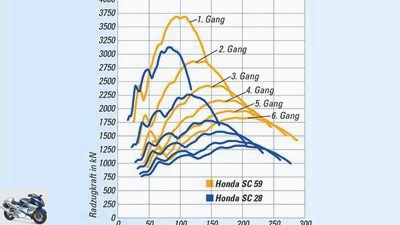
archive
The pulling force in comparison.
Tensile force diagram:
Here it becomes really clear what is going on. The diagram shows at which speed in which gear what kind of tractive force is applied to the rear wheel. From this it becomes clear that the SC 28 (blue line) does not even come close to balancing the tractive force on the rear wheel in fourth gear like the SC 59 in sixth. If the old one wants to keep up with the new one between 100 and 150 km / h, she has to drive in third gear.
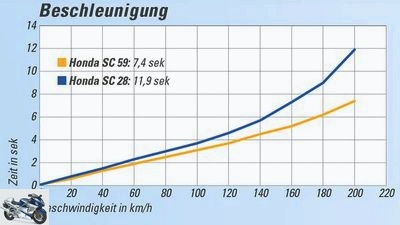
archive
Certification of the old and new blade.
Acceleration made visible: What the figures of the sober acceleration values from 0 to 200 km / h do not show, this graphic illustrates. A CBR 1000 RR type SC 59 accelerates from 0 to 200 km / h in 7.2 seconds (yellow line). The old CBR 900 RR type SC 28 needs 11.9 seconds for this. If it can keep up to a certain extent up to 100 km / h, it starts to lose ground from 130 km / h. At this speed you only need two things to accelerate: good aerodynamics and a lot of power.
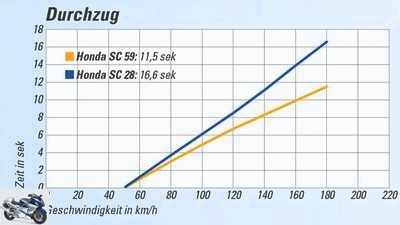
archive
A similar picture is also shown in the draft diagram.
The pull-through diagram shows a very similar picture. In the last gear it is fully opened at 50 km / h. The SC 59 already starts to pull away at 70 km / h, the old Fireblade has no chance despite a very similar vehicle mass and a shorter overall gear ratio. The 900 simply doesn’t generate the unyielding thrust of the 1000 and has to be poured for 5.1 seconds up to 200 km / h. It feels like an eternity, especially when driving lazily on the country road.
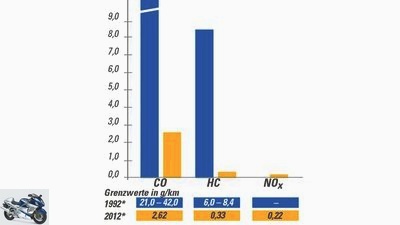
archive
Adaptation to the significantly different exhaust gas limit values.
Exhaust gases:
The blue bars represent the emission limit values applicable in 1992 for motorcycles such as the CBR 900 RR. The yellow ones correspond to the EURO III regulation that has been in place since 2006. The limit values that apply today illustrate the high demands placed on modern injection systems including exhaust gas cleaning. The fact that the exhaust gas from a CBR 1000 RR is still poisonous is due to the nature of the internal combustion engine.

Super athlete
Technology 20 years of progress in motorcycle construction
20 years of Fireblade: Part 1
read more
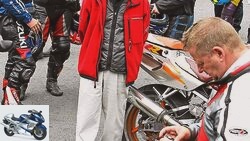
Sports & scene
Portrait: Tadao Baba
The father of the Honda Fireblade
read more
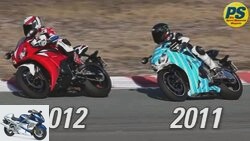
Super athlete
Driving report: Honda CBR 1000 RR Fireblade
Honda’s 2012 super sports car
read more
Related articles
-
Technology: BMW S 1000 RR engine in detail
BMW 13th pictures Artist 1/13 The on-board tool kit of the BMW almost ties in with old traditions. With the help of the nine-part set you can strip the…
-
This is how the new super sports technology works
Suzuki 20th pictures Suzuki 1/20 The Suzuki GSX-R combines high tech with clever engineering. Suzuki 2/20 This centrifugal force mimic adjusts the timing…
-
Engine cooling technology: Air cooling will soon be obsolete?
Photos: Manufacturer motorcycles Engine cooling technology: air cooling will soon be obsolete? Technology: engine cooling Air cooling will soon be…
-
Technology of the new 600 super sports car
counselor technology & future Technology of the new 600 super sports car Technology of the new 600 super sports car New base The new 600 super athletes…
-
New super sports cars from BMW, Buell and Aprilia
Drawing; power counselor technology & future New super sports cars from BMW, Buell and Aprilia New super sports cars from BMW, Buell and Aprilia Project…
-
Technology of the new Ducati engine
counselor technology & future Technology of the new Ducati engine Technology of the new Ducati engine Now it’s getting tight 13 years ago, the four-valve…
-
MV Agusta F3 engine: the technology
manufacturer counselor technology & future MV Agusta F3 engine: the technology Technology: MV Agusta F3 engine The engine of the super sports car from MV…
-
A comparison of the super sports car MV Agusta F3 675 and Triumph Daytona 675
jkuenstle.de 11 pictures jkuenstle.de 1/11 The Triumph Daytona 675 (right) breaks all prejudices against 600s – at the same time, the elegant and handy…
-
Guide: Technology – engine lubrication
BILLION counselor workshop Guide: Technology – engine lubrication Guide: Technology – Motors and Drive Everything about engine lubrication To ensure…
-
Market analysis The decline of the 600 super sports car
Diagram: MOTORCYCLE 43 pictures fact 1/43 Positive: engine speed hornier, more toxic Engine, chassis consistently geared towards racing Model RJ11…